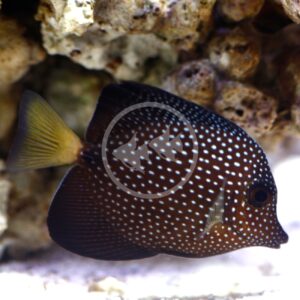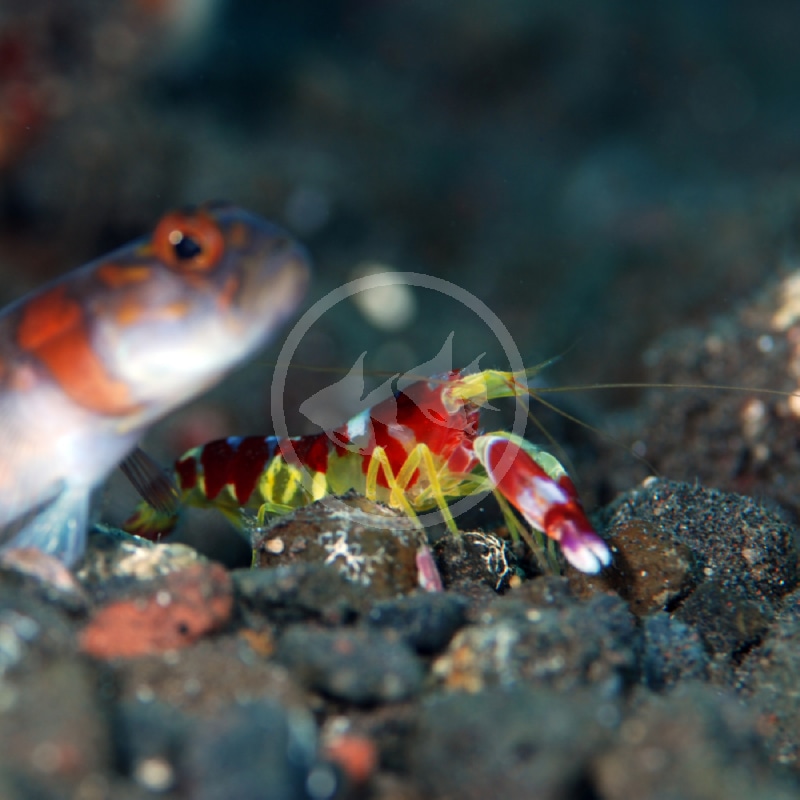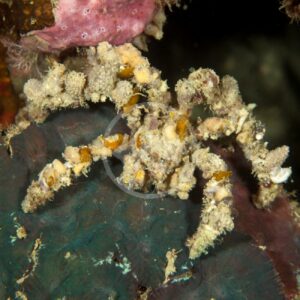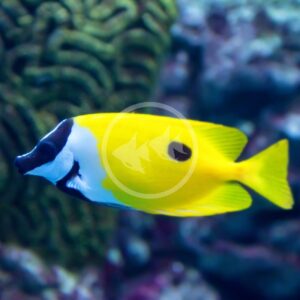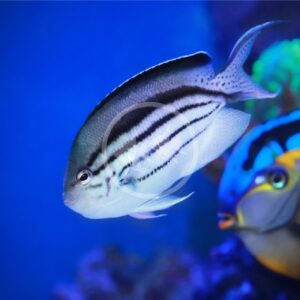
SHRIMP – CANDY PISTOL Alpheus randalli
$39.99 – $49.99Price range: $39.99 through $49.99
The Candy Pistol Shrimp, also known as the Red Banded Pistol Shrimp or Snapping Shrimp, have red and white bands along the dorsal side of its body, yellow on the ventral side, and a uniquely larger left claw. In the aquarium, when this claw opens and closes, it sounds like a loud clicking noise. Candy pistol shrimp originate from the Indo-Pacific and reach a maximum size of approximately 2″. More of a nocturnal forager, the Candy pistol shrimp may be seldomly seen out and about during the day. These shrimp make a burrow under liverock, which will be shared with a goby typically from the Amblyeleotris or Stonogobiops genera in a symbiotic relationship. Because these shrimp have poor eye sight, the goby acts as a look out for predators while the shrimp provides a home for the goby; both also benefit in sharing food resources. Popular compatible gobies include Randall’s Goby (Amblyeleotris randalli), Antenna Hifin Goby (Stonogobiops nematodes), Yasha Goby (Stonogobiops yasha), and Yellow Watchman Goby (Cryptocentrus cinctus).
Care Level: Easy
Temperament: Peaceful
Reef Compatible: Yes
General Description: The Candy Pistol Shrimp, also known as the Red Banded Pistol Shrimp or Snapping Shrimp, have red and white bands along the dorsal side of its body, yellow on the ventral side, and a uniquely larger left claw. In the aquarium, when this claw opens and closes, it sounds like a loud clicking noise. Candy pistol shrimp originate from the Indo-Pacific and reach a maximum size of approximately 2″. More of a nocturnal forager, the Candy pistol shrimp may be seldomly seen out and about during the day. These shrimp make a burrow under liverock, which will be shared with a goby typically from the Amblyeleotris or Stonogobiops genera in a symbiotic relationship. Because these shrimp have poor eye sight, the goby acts as a look out for predators while the shrimp provides a home for the goby; both also benefit in sharing food resources. Popular compatible gobies include Randall’s Goby (Amblyeleotris randalli), Antenna Hifin Goby (Stonogobiops nematodes), Yasha Goby (Stonogobiops yasha), and Yellow Watchman Goby (Cryptocentrus cinctus).
Diet Requirements: Candy pistol shrimp are carnivores. They will forage on the substrate for meaty foods, such as frozen brine shrimp or mysis shrimp, and various pellet foods.
Tank Requirements: An established, minimum aquarium size of 15 gallons with a deep sand bed for burrowing is recommended to house a Candy pistol shrimp alone, or a Candy pistol shrimp and goby pair. Maintaining stable water parameters is a component to the success of keeping this invertebrate; Candy pistol shrimp are intolerable of high nitrates. Regular water changes are necessary to replenish iodine that is important for the proper molting of Candy pistol shrimp. Generous live rock and caves will mimic the Candy pistol shrimp’s natural environment. Recommended water conditions: 76-78° F, dKH 8-12, pH 8.1-8.4, salinity 1.024-1.026.
Purchase Size: 3/4″ to 1″
Note: Your item may not look identical to the image provided due to variation within species. Purchase size is approximate.
Dry goods orders are shipped via US Postal Service or UPS to the address provided at checkout based on the selection made in your website shopping cart. Product is carefully packed to help prevent any damage during shipping. Once processed you will receive a shipment notification via email with tracking number, and delivery notification. Please allow 48 hours for processing after your order is placed.
Perishable items (i.e. live plants, refrigerated/frozen foods) are shipped via US Postal Service 2-3 day to the address provided at checkout for a $25.00 flat rate charge. Items are packed with secure packing material and heat, cold, or Cryo packs as needed to maintain safe temperatures during transit. If one or more perishable items are in the shopping cart at checkout the $25.00 perishable shipping charge will automatically appear and need to be selected. Once processed you will receive a shipment notification via email with tracking number. Please allow 48 hours for processing after your order is placed.
Livestock (i.e. fish, invertebrates, coral) are shipped via UPS Overnight to the address provided at checkout for a $55.00 flat rate charge. Livestock is packed in insulated styrofoam boxes with secure packing material and heat, cold, or Cryo packs as needed to maintain safe temperatures during transit. If one or more livestock items are in the shopping cart at checkout the $55.00 livestock shipping charge will automatically appear and need to be selected. Livestock is shipped Monday through Wednesday ONLY (no weekend delivery is available) weather permitting, and we reserve the right to delay shipping until conditions are appropriate for safe arrival. Once your order is placed we will contact you to arrange the best shipping date based on these criteria. Someone must be available to receive the livestock order on the first delivery attempt. Once processed you will receive a shipment notification via email with tracking number. Please allow 48 hours for processing after your order is placed.
For mixed dry goods/perishable & livestock orders items will be shipped via their corresponding shipping methods outlined above. Dry goods will be shipped via US Postal Service or UPS based on your selection and checkout, while livestock will ship via UPS Overnight for a $55.00 flat rate charge. You will receive separate notifications and tracking numbers for the dry goods and livestock. Please note due to different carriers and shipping methods dry goods and livestock may arrive on different days.
Related products
RABBITFISH – ONE SPOT FOXFACE Siganus unimaculatus
$119.99 – $199.99Price range: $119.99 through $199.99
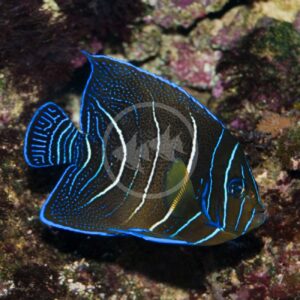
ANGEL – KORAN Pomacanthus semicirculatus
$89.99 – $189.99Price range: $89.99 through $189.99

TANG – SOHAL Acanthurus sohal
$289.99 – $319.99Price range: $289.99 through $319.99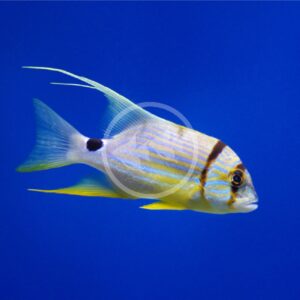

SNAPPER – HI FIN Symphorichthys spilurus
$149.99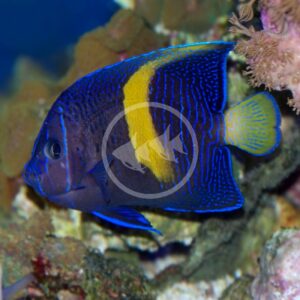

ANGEL – MACULOSUS Pomacanthus maculosus
$254.99ANGEL – LAMARCK Genicanthus lamarck
$99.99 – $299.99Price range: $99.99 through $299.99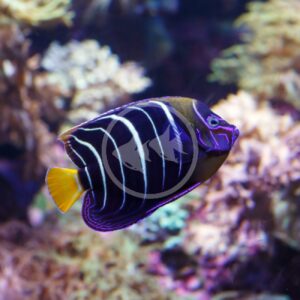

ANGEL – CHRYSURUS Pomacanthus chrysurus
$269.99